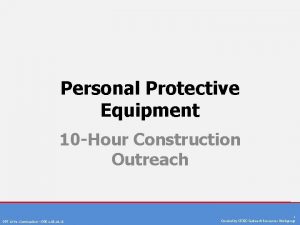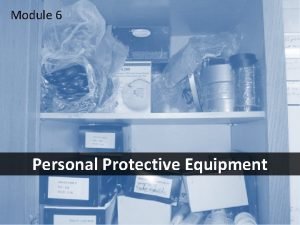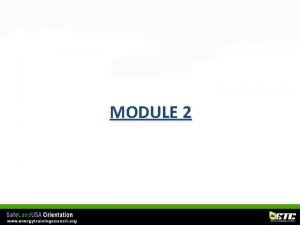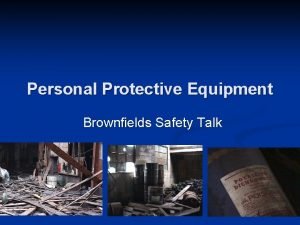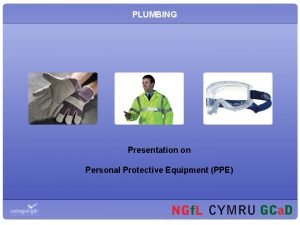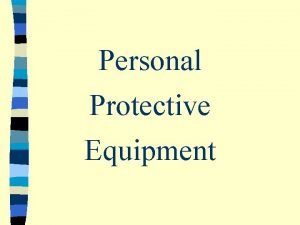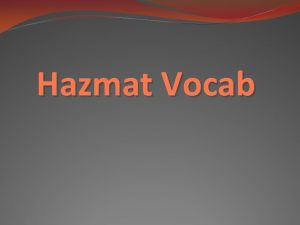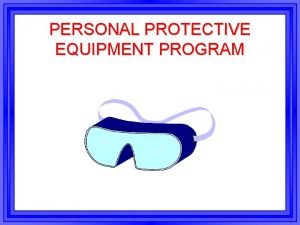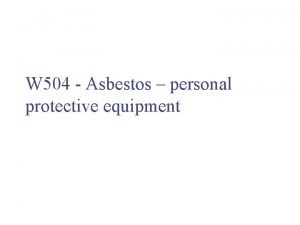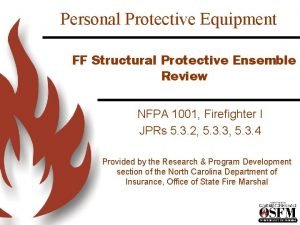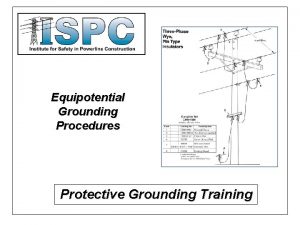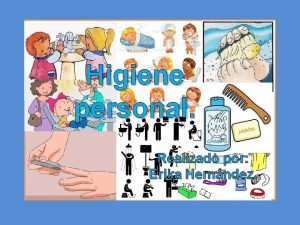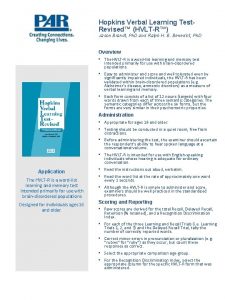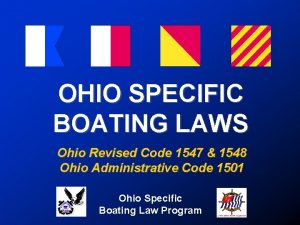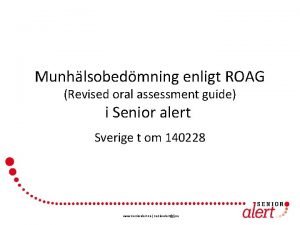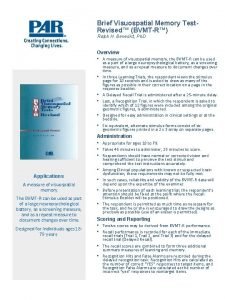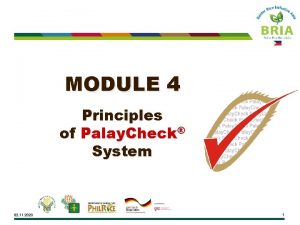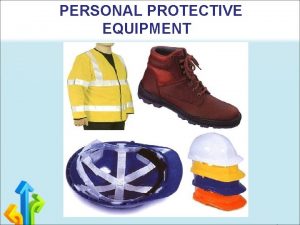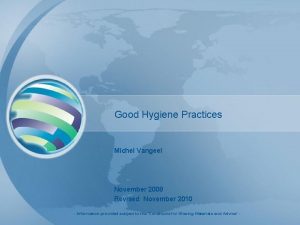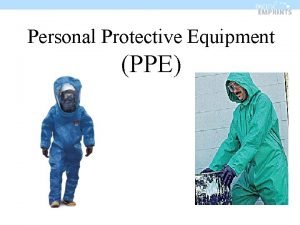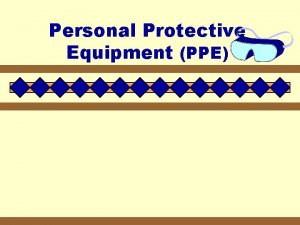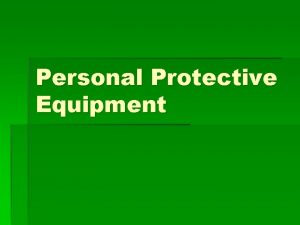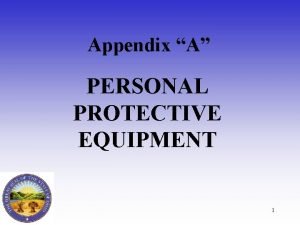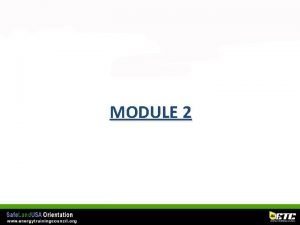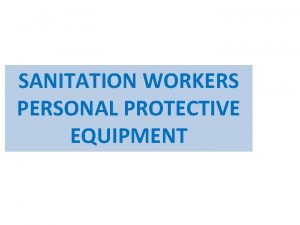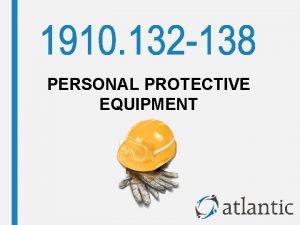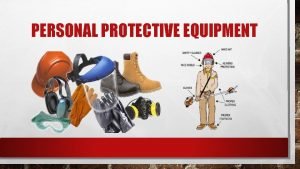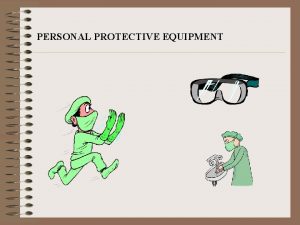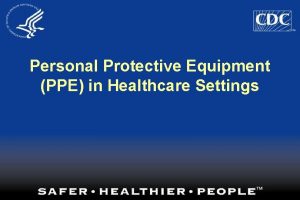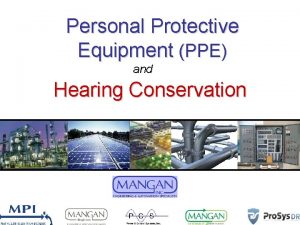Personal Protective Equipment Michel Vangeel April 2008 Revised





![Types of hazards, continued (more on chemical exposure) n Causes of occupational dermatitis [NIOSH] Types of hazards, continued (more on chemical exposure) n Causes of occupational dermatitis [NIOSH]](https://slidetodoc.com/presentation_image_h/9d426c27aa1babc91bc0cdbbff4d38b2/image-6.jpg)


























































- Slides: 64

Personal Protective Equipment Michel Vangeel April 2008 Revised November 2010 - Information provided subject to the 'Conditions for Sharing Materials and Advice' -

Outline This presentation describes: n n The Personal Protective Equipment (PPE) available How to use PPE to ensure it protects you fully How to check PPE How to maintain and store PPE 2

Personal Protective Equipment PPE n n n Standard PPE Hearing Protection Chemical Protective Clothing CPC – Overalls – Gloves n Respiratory Protective Equipment RPE 3

Routes of entry (or routes of exposure) Eye splash ingestion inhalation skin 4

Types of hazards related to protective equipment n Chemical – Toxic (e. g. , poison, potent pharmaceutical ingredients) – Corrosive (e. g. , acids, bases, reactive chemicals) n Physical – – n n Mechanical (e. g. , sharp objects, vibration) Thermal (e. g. , heat and cold extremes) Noise Radiation (e. g. , welding) Biological Other – Weather-related – Visibility 5
![Types of hazards continued more on chemical exposure n Causes of occupational dermatitis NIOSH Types of hazards, continued (more on chemical exposure) n Causes of occupational dermatitis [NIOSH]](https://slidetodoc.com/presentation_image_h/9d426c27aa1babc91bc0cdbbff4d38b2/image-6.jpg)
Types of hazards, continued (more on chemical exposure) n Causes of occupational dermatitis [NIOSH] – Chemical u Primary irritation (~80% of industrial cases) – Damage at site of contact – Direct chemical or physical action – No preceding event (e. g. , no sensitization) required u Sensitization (~20% of industrial cases) – Some allergens examples: u Epoxy resins u Some plants u Chromates u Nickel u Rubber chemicals u Some pharmaceutical ingredients 6

Possible adverse outcome examples (slide 1) Irritant contact dermatitis resulting from exposure to fiberglass. Chronic dermatitis from long-term exposure to solvent. 7

Possible adverse outcome examples (slide 2) Skin de-pigmentation resulting from chemical exposure. Allergic dermatitis resulting from exposure to dichromate in cement. 8

Hierarchy of controls (in order of decreasing preference) n Elimination – Grind rough or sharp edges to smooth n Substitution – Replace with less hazardous material – Avoid creating different hazard (e. g. , substitute toxic with flammable) n n Engineering - Closed systems - Ventilation; process enclosure Administrative – Work rotation, e. g. , “share” the exposure n Personal protective equipment 9

Additional control elements n Good work practices – Performing activities to minimize exposure n Good personal hygiene practices – Periodic hand face washing – No eating, tobacco use, etc. , in work area – Keeping items like safety glasses clean n n Employee awareness Good housekeeping – Cleaning spills promptly and thoroughly – Keeping work surfaces and tools clean 10

Employee knowledge and skill n Personal protective equipment and “hazcom” – Employee knowledge of hazards Container labels u Material safety data sheets u Training u Facility history u n Training on protective equipment use – – When to use [and when safe to remove] How to select Pre-use inspection Proper donning and doffing techniques 11

Basic principles PPE = all “open” activities with possibility of direct contact with chemical agents see summary safety instruction 12

General limitations of personal protective equipment n A direct barrier between the individual and the hazard – If the barrier fails, the individual may be exposed. – Failure of the barrier may not be immediately apparent. – Degradation and/or permeation of the barrier. n Requires a degree of diligence by the wearer – Proper selection, inspection, and donning every time used. – Selection is appropriate for the hazard expected. n n n May contribute to heat stress. May reduce individual’s dexterity. Inventory control: Variations between different manufacturer’s of personal protective equipment. 13

General types of personal protective equipment n n n Hand protection, e. g. , gloves Body protection Eye protection Face protection Hearing protection Respiratory protection – not addressed in this presentation n Fall protection – not addressed in this presentation n Combinations, ensembles 14

Hand protection, typical glove materials of construction n For chemical resistance – – – – n Butyl Natural rubber Neoprene Nitrile PVA (poly vinyl alcohol) PVC Viton® Cut or abrasion resistance – Aramid fiber, e. g. , Kevlar® – Leather – Nitrile-dipped cotton 15

Hand protection, glove size approximation Circumference: With flexible tape measure, wrap around palm, below knuckles (do not include thumb), and make a fist. Length: Measure from bottom edge of the palm to the tip of middle finger. 16

Hand protection, supplemental protection n Inner glove to provide additional protection – Example: Silver Shield® by North Safety Products n Outer glove may provide mechanical protection 17

Chemical Protective Gloves n If in direct contact with chemicals, use designated, labelled, gloves n Gloves may be disposable or reusable Disposable silver shield gloves Reusable butyl gloves 18

Gloves – Before use n Hands must be clean and dry before putting on gloves. Contaminated hands in gloves is worse than no gloves n Cover any cuts or grazes with a plaster before putting on gloves n Roll up the opening to trap air in glove – check it holds pressure n Ensure they fit you properly n For reusable gloves, make sure they are clean and in good condition 19

Gloves – during use n Check throughout task for tears, punctures, discolouration, stiffening, softening – remove and replace as soon as safely possible n Change after 1 hours use, if feasible – Allow hands to dry before replacing gloves n Protect the skin above the gloves – Tape or tuck sleeves, or use gauntlets n n Use double gloves whenever you may need to change gloves in contaminated area Avoid touching clean areas with contaminated gloves 20

Gloves – after use n Remove gloves carefully – May need to clean before removal – Do not touch outside of gloves with bare hands during removal n n Wash hands before eating, drinking etc. For reusable gloves, clean and dry after use and store in a clean location 21

22

23

Caution when using gloves n Breakthrough can occur if you are using gloves for too long n The recommended wear time depends on the glove and the substance – follow manufacturer’s advice n Change them after the recommended time - they might still look and feel fine n Frequent use of gloves can lead to dermatitis Example of oil contamination through a dirty glove 24

Gloves – dermatitis Protect against dermatitis n n n Use barrier creams Use cotton undergloves Ensure hands are dry and soap free before putting on gloves Apply Moisture cream after glove use (NOT before) Monitor hand condition daily Report any adverse conditions 25

Chemical Protective Overalls 26

Body protection, various types n Coveralls – Protects most of body Legs, arms, torso u May also include head and feet u – Different styles to protect against: Particulate, e. g. , dust u Chemical, e. g. , spray or splash u Thermal, e. g. , flash fire u n n Aprons Sleeves 27

Body protection, over-sleeves n Multi-function – Seal gap between glove and coveralls – Mechanical protection of wrist and forearm – When coveralls are not needed, but arm protection is 28

Chemical Protective Overalls – Before use n Check it is the right one for the job n Inspect for defects such as imperfects seams, pinholes, tears n Flex the surface to test for cracks n A simple torch can help find faults n Make sure all closures are completely and securely fastened 29

Chemical Protective Overalls – during use n Check throughout task for tears, punctures, discolouration, stiffening, softening n If damaged or seriously contaminated, replace as soon as it is safe to do so n Be aware of heat stress and take plenty of fluids 30

Chemical Protective Overalls – after use Do n Wet wipe or vacuum overalls before removal n Remove overalls carefully, by rolling down n Dispose of immediately – into hazardous waste, if disposable – in designated laundry bin, if reusable n Store new/clean garments separately from used n Follow manufacturer’s instructions for storage, maintenance and usage life 31

Chemical Protective Overalls – after use Don’t n Do not blow down with air n Do not brush down n Do not remove CPC from the production areas 32

Eye protection n Hazards – Foreign bodies u Sand, debris, dust – Irritation – Corneal abrasion – Embedded object u Flying objects, etc. , penetrates eye – Chemical exposure Liquid, e. g. , spray or splash u Vapor u – Optical radiation Welding flash u Laser u – Blunt force trauma to eye area 33

Eye protection, safety glasses n General type of lenses – “Plano” – Prescription n Specialty lenses – Dark shades – Laser n Side shields 34

Eye Protection – Safety Glasses n Safety glasses should be worn throughout process areas n Use prescription or over spectacle type for corrected vision n Ensure good fit – contact at nose and behind ears n Consult safety personnel if you wear contact lenses 35

Eye protection, goggles n Application – – – Chemical spray or splash Dust Impact Gas-tight models (e. g. , formaldehyde vapor) Overhead work (e. g. , falling debris that could get past standard safety glasses). 36

Eye protection, safety note about goggles n Avoid goggle retaining straps that attach directly to a hardhat: – May provide a less-than-optimum seal (compared to “strap behind the head” donning) – With spray or splash scenario, the hard hat often falls off (as individual’s head recoils), thereby also pulling the goggles off the individual’s face. 37

Eye Protection – safety goggles n Use goggles for greater particle protection and chemical splashes n Ensure that there is a good seal between face and goggles n Goggles for splash or high dust protection should have indirect venting (no holes around sides) n Goggles with direct venting (a mesh of small holes around the sides) tend to fog less, and can be used with large particle dust hazards 38

Face protection, the face shield n Limitations – A face shield is considered “secondary” protection; a face shield should not be used alone, e. g. , without safety glasses or goggles, depending on the hazard. n Application – Impact – Chemical spray or splash – Radiant energy n Other – Head band or hardhat mounting options – A full face respirator is typically considered equivalent protection to a goggles and face shield combination. 39

Face Shields n Face shields protect the entire face from a variety of chemical hazards. n Use face shield with chin guard if there might be splashes from the chest area n Face shields must be used in addition to safety goggles to provide adequate protection. 40

Eye and face protection, welding shield n Select appropriate lens shade based on: – Type of welding operation and energy level – Selected examples: 41

Maintenance and storage of protective eyewear n Use anti-fog solution regularly n Store glasses/goggles/faceshields carefully to avoid them getting scratched n Use a glasses cleaning station or wash and wipe with a soft clean cloth n Disinfect goggles regularly n Replace when scratched, and when retaining band is worn Don’t store them like this 42

Head protection n Hazards to head – Struck by falling object – Striking against stationary object (e. g. , low pipes) – Energized electrical components n Two primary styles – Hard hat – Bump cap 43

Hearing Protection n Wear hearing protectors when noise exposure exceeds 82 d. B(A) n Use of hearing protection is detailed in Noise and Hearing Conservation presentation 44

Hearing protection 45

Foot protection n Chemical resistance Static dissipative Crush-resistance – Toe – Metatarsal n Combinations 46

Safety Footwear 47

Mind the gap n Gap between protective garments – Gloves and coveralls – Boots and coveralls – Respirator and coveralls n Addressing the gap – – – Elastic cuffs (e. g. , ankle, wrist, and hood) Storm flaps with adhesive Chem. Tape® Over-sleeves Integral equipment (e. g. , gloves part of suit) 48

Mind the gap, Kappler™ Chem. Tape® Kappler’s Chem. Tape® has documented chemical resistance; a better application than standard “duct tape. ” 49

Mind the gap, boots and coveralls options Coveralls with integral bootie (sock). Possible slipping hazard, depending on walking surface. Du. Pont Tychem BR suit material and styles shown. Coveralls with elastic cuff at ankle. Elastic is placed over the boot to form a seal. Can be taped to boot for additional protection. Coveralls with integral bootie (sock) and integral storm flap. Bootie inserted in boot and storm flap covers the boot to keep liquid out of boot. 50

Terminology related to evaluation and selection n Degradation – A description of how an exposure to a chemical affects the physical properties of personal protective equipment, e. g. , softening, becoming brittle, etc. . – May be seen on charts as descriptive evaluation, e. g. , “excellent” or “poor. ” n Permeation – A description of how quickly a particular chemical can penetrate through personal protective equipment. – Often seen on charts in unit of “minutes, ” e. g. , breakthrough time. 51

PPE matrix, simplified example (for gloves or suits) 52

Ensembles: Level of protection (US) n Level D – Coveralls; safety boots or shoes with chemical-resistant steel toe and shank; other as necessary n Level C – Air purifying respirator; hooded chemical-resistant clothing; outer gloves; inner gloves (both chemical-resistant) n Level B – Supplied air respirator with egress (e. g. , SCBA); hooded chemicalresistant clothing; outer gloves; inner gloves (both chemicalresistant); safety boots with chemical-resistant steel toe and shank n Level A – Supplied air respirator with egress (e. g. , SCBA); totallyencapsulating chemical-protective suit; outer gloves; inner gloves (both chemical-resistant); safety boots with chemical-resistant steel toe and shank 53

Ensemble examples, Level A (“hazmat”) 54

Ensemble example, chemical operator (“Level C”) n n Air-purifying respirator Chemical-resistant gloves Coveralls Safety shoes/boots 55

Ensemble example, chemical operator (“Level D”) n n Safety glasses with side shields Head protection Work uniform Safety shoes/boots 56

Ensemble example, specific application, welding n n n Face shield with appropriate lens Spark-resistant coat Heat-resistant gloves Safety boots [Local exhaust ventilation] 57

Ensemble example, specific application, fire fighting 58

Ensemble example, general lab work n n Safety glasses with side shields Lab coat 59

Standard Protective Clothing – do’s and don’t Do n n Keep coveralls closed Change coverall regularly Change coverall immediately when dirty Store coveralls separately from street clothes Don’t n n n Do not roll up sleeves Do not leave coverall in production area Do not bring work coveralls home to the family – you may not see it, but they could be contaminated with hazardous material 60

Heat stress and PPE n n Chemical resistant clothes may not allow perspiration to evaporate, body looses important cooling mechanism. Possible solutions – – Ice vests Vortex tubes Work-rest regimens Acclimatization and pre-hydration, re-hydration 61

Safety shower and eyewash stations n Although not “PPE, ” per se, in some situations (e. g. , in an emergency), a functional safety shower and eyewash station can supplement personal protective equipment. 62

Fall protection, three primary components n Anchorage point Deceleration device Full body harness n Fall protection is beyond the scope of this presentation n n 63

Suggested sources of further information n Ansell – www. ansellpro. com – Glove selection software n Best – www. bestglove. com – Glove selection software (Chem. Rest) n Du. Pont – www. personalprotection. dupont. com – Suit selection software n OSHA (US) – www. osha. gov n HSE (UK) – www. hse. gov. uk 64
 Who is responsible for providing specialized work footwear
Who is responsible for providing specialized work footwear Ppe in plumbing
Ppe in plumbing 6 personal protective equipment
6 personal protective equipment Personal protective equipment pictograms
Personal protective equipment pictograms Smaw welding ppe
Smaw welding ppe Importance of using personal protective equipment
Importance of using personal protective equipment Personal protective equipment safety talk
Personal protective equipment safety talk Ignorganic chemical equipment
Ignorganic chemical equipment Plumber ppe
Plumber ppe Ppe matrix doc
Ppe matrix doc Personal protective equipment list
Personal protective equipment list Personal protective equipment vocabulary
Personal protective equipment vocabulary Program
Program Asbestos personal protective equipment
Asbestos personal protective equipment Personal protective equipment for farmers
Personal protective equipment for farmers Summary of personal protective equipment
Summary of personal protective equipment 3 april 2008
3 april 2008 2008 2008
2008 2008 Special protective equipment used in firefighting except
Special protective equipment used in firefighting except Personal protective factor
Personal protective factor Equipotential grounding
Equipotential grounding Cuales son las formas no personales de los verbos
Cuales son las formas no personales de los verbos Adivinanzas de higiene personal
Adivinanzas de higiene personal Mga dapat isaalang alang sa sariling pagtataya
Mga dapat isaalang alang sa sariling pagtataya Revised curriculum 2020
Revised curriculum 2020 Bloom's revised taxonomy
Bloom's revised taxonomy Electrical technology grade 12
Electrical technology grade 12 Isa 315
Isa 315 Revised cardiac risk index
Revised cardiac risk index Revised flacc scale
Revised flacc scale 2020 revised curriculum and assessment plans
2020 revised curriculum and assessment plans Simplex method adalah
Simplex method adalah Sa 700 revised
Sa 700 revised Ghg protocol revised
Ghg protocol revised 2020 revised curriculum and assessment plans
2020 revised curriculum and assessment plans Revised profiles of the gifted and talented
Revised profiles of the gifted and talented 2020 revised curriculum and assessment plans
2020 revised curriculum and assessment plans Caltrans standard special provisions
Caltrans standard special provisions 2020 revised curriculum and assessment plans grade 7
2020 revised curriculum and assessment plans grade 7 2020 revised curriculum and assessment plans
2020 revised curriculum and assessment plans Revised programme of assessment 2020
Revised programme of assessment 2020 Hvltr
Hvltr Kalkulator metode simpleks
Kalkulator metode simpleks Tracer study tool sbm
Tracer study tool sbm Expired tags orc
Expired tags orc Roag formulär
Roag formulär 2020 revised curriculum and assessment plans
2020 revised curriculum and assessment plans Express (32)10 in the revised 14-bit floating-point model
Express (32)10 in the revised 14-bit floating-point model Revised annual teaching plans 2020
Revised annual teaching plans 2020 Revised trauma score
Revised trauma score Isa 540
Isa 540 2020 revised curriculum and assessment plans
2020 revised curriculum and assessment plans A revised version of little red riding hood answers
A revised version of little red riding hood answers Department of education revised curriculum 2020
Department of education revised curriculum 2020 2020 revised curriculum and assessment plans
2020 revised curriculum and assessment plans Revised primary curriculum grade 1-3
Revised primary curriculum grade 1-3 2020 revised curriculum and assessment plans
2020 revised curriculum and assessment plans Hksa240
Hksa240 Taskpat
Taskpat Visuospatial memory test
Visuospatial memory test Grade 6 geography term 1 test
Grade 6 geography term 1 test Revised curriculum and assessment plans 2021
Revised curriculum and assessment plans 2021 Cs form no. 33-a revised 2018
Cs form no. 33-a revised 2018 Changes in schedule vi
Changes in schedule vi Ano ang palay check system
Ano ang palay check system
